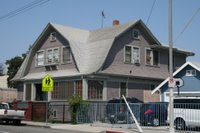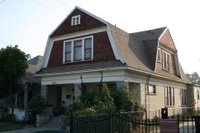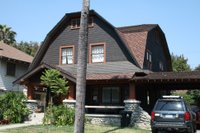Shingle Style (Part 2)
 Whereas Los Angeles offers few examples of the prototypical Shingle (or Seaside) Style, owing to its period of development, aesthetic leanings, or even the dearth of wide frontage lots to indulge its rambling masses, one Shingle Style sub-set appears in large numbers.
Whereas Los Angeles offers few examples of the prototypical Shingle (or Seaside) Style, owing to its period of development, aesthetic leanings, or even the dearth of wide frontage lots to indulge its rambling masses, one Shingle Style sub-set appears in large numbers.Houses, largely clad in shingles, with simple and complex gambrel roof lines, appear in most neighborhoods with Arts & Crafts era
 architecture.
architecture.Architect John Calvin Stevens, of Portland Maine, a progenitor of the Shingle Style, is often credited with the revival of the gambrel roof, possibly inspired by Dutch Colonial architectural, which like other early American forms, was being reconsidered around the time of the American centennial.
 A gambrel roof is generally symmetrical, with two slopes on each side. The uppermost slope tends to be quite slight (which allows for more headroom in interiors), while the lower slope is steep.
A gambrel roof is generally symmetrical, with two slopes on each side. The uppermost slope tends to be quite slight (which allows for more headroom in interiors), while the lower slope is steep.The example left, is clipped at the gable, and boasts deeper eaves, a characteristic that's referred to as "sunbonnet".
While some classic elements, columns or palladian windows, are borrowed from elsewhere, note the absence of applied ornamentation.
Labels: Architecture

0 Comments:
Post a Comment
Comments
<< Home